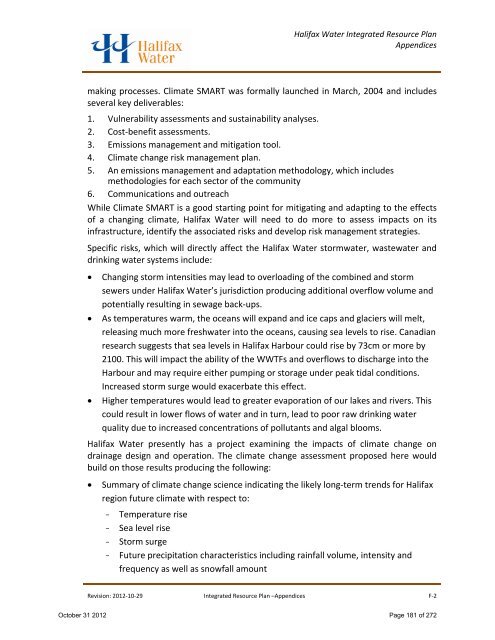volume 1 - Halifax Regional Municipality
volume 1 - Halifax Regional Municipality
volume 1 - Halifax Regional Municipality
You also want an ePaper? Increase the reach of your titles
YUMPU automatically turns print PDFs into web optimized ePapers that Google loves.
<strong>Halifax</strong> Water Integrated Resource Plan<br />
Appendices<br />
making processes. Climate SMART was formally launched in March, 2004 and includes<br />
several key deliverables:<br />
1. Vulnerability assessments and sustainability analyses.<br />
2. Cost-benefit assessments.<br />
3. Emissions management and mitigation tool.<br />
4. Climate change risk management plan.<br />
5. An emissions management and adaptation methodology, which includes<br />
methodologies for each sector of the community<br />
6. Communications and outreach<br />
While Climate SMART is a good starting point for mitigating and adapting to the effects<br />
of a changing climate, <strong>Halifax</strong> Water will need to do more to assess impacts on its<br />
infrastructure, identify the associated risks and develop risk management strategies.<br />
Specific risks, which will directly affect the <strong>Halifax</strong> Water stormwater, wastewater and<br />
drinking water systems include:<br />
• Changing storm intensities may lead to overloading of the combined and storm<br />
sewers under <strong>Halifax</strong> Water’s jurisdiction producing additional overflow <strong>volume</strong> and<br />
potentially resulting in sewage back-ups.<br />
• As temperatures warm, the oceans will expand and ice caps and glaciers will melt,<br />
releasing much more freshwater into the oceans, causing sea levels to rise. Canadian<br />
research suggests that sea levels in <strong>Halifax</strong> Harbour could rise by 73cm or more by<br />
2100. This will impact the ability of the WWTFs and overflows to discharge into the<br />
Harbour and may require either pumping or storage under peak tidal conditions.<br />
Increased storm surge would exacerbate this effect.<br />
• Higher temperatures would lead to greater evaporation of our lakes and rivers. This<br />
could result in lower flows of water and in turn, lead to poor raw drinking water<br />
quality due to increased concentrations of pollutants and algal blooms.<br />
<strong>Halifax</strong> Water presently has a project examining the impacts of climate change on<br />
drainage design and operation. The climate change assessment proposed here would<br />
build on those results producing the following:<br />
• Summary of climate change science indicating the likely long-term trends for <strong>Halifax</strong><br />
region future climate with respect to:<br />
- Temperature rise<br />
- Sea level rise<br />
- Storm surge<br />
- Future precipitation characteristics including rainfall <strong>volume</strong>, intensity and<br />
frequency as well as snowfall amount<br />
Revision: 2012-10-29 Integrated Resource Plan –Appendices F-2<br />
October 31 2012 Page 181 of 272
















